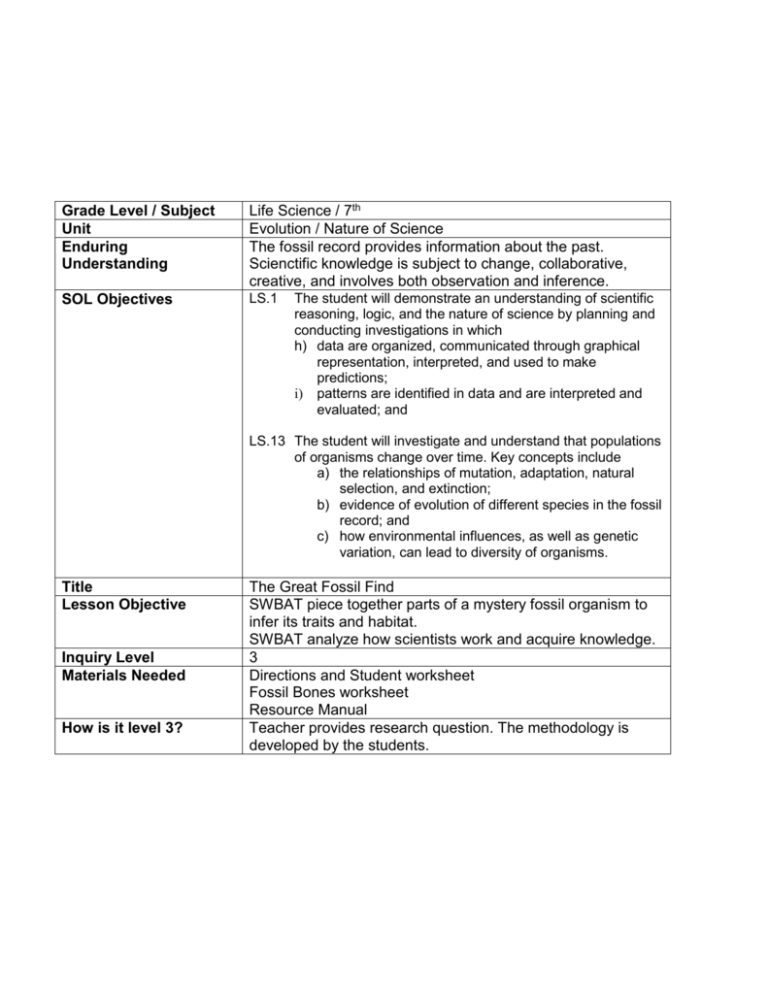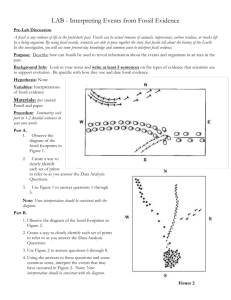Fossil Find: Evolution Lesson Plan for 7th Grade Science
advertisement

Grade Level / Subject Unit Enduring Understanding Life Science / 7th Evolution / Nature of Science The fossil record provides information about the past. Scienctific knowledge is subject to change, collaborative, creative, and involves both observation and inference. SOL Objectives LS.1 The student will demonstrate an understanding of scientific reasoning, logic, and the nature of science by planning and conducting investigations in which h) data are organized, communicated through graphical representation, interpreted, and used to make predictions; i) patterns are identified in data and are interpreted and evaluated; and LS.13 The student will investigate and understand that populations of organisms change over time. Key concepts include a) the relationships of mutation, adaptation, natural selection, and extinction; b) evidence of evolution of different species in the fossil record; and c) how environmental influences, as well as genetic variation, can lead to diversity of organisms. Title Lesson Objective Inquiry Level Materials Needed How is it level 3? The Great Fossil Find SWBAT piece together parts of a mystery fossil organism to infer its traits and habitat. SWBAT analyze how scientists work and acquire knowledge. 3 Directions and Student worksheet Fossil Bones worksheet Resource Manual Teacher provides research question. The methodology is developed by the students. The Great Fossil Find This lab has been adapted from a University of Indiana Lesson http://www.indiana.edu/~ensiweb/lessons/gr.fs.fd.html [READ TO STUDENTS with ENTHUSIASM!] The purpose of this activity is to gain a better understanding of how scientists work and how important fossils are to our understanding of how organisms have evolved. In this activity, you and the members of your team will play the roles of paleontologists working in the field in Montana, near the town of Randak. One clear crisp afternoon in October, you find four well- preserved and complete fossil bones. (Withdraw four fossil bones from your envelope. Make sure you take them out without looking at the ones remaining in the envelope!) It is too late in the day to continue with the dig, so you return to camp with your find. A. That night, in camp, after dinner, around a Coleman lantern, you and your colleagues begin to assemble the 4 bones you found earlier. Since the bones were all found together and in an undisturbed layer, you assume that they are all from the same animal. You spend the rest of the evening trying different arrangements of the bones in hopes of identifying the animal. (Use the next 3-5 minutes to try various combinations.) As the night wears on, you get weary and decide to retire and begin anew in the morning. (Before you go to bed, jot down on your worksheet the type of animal you think it might be.) B. Montana mornings are marvelous. They are clear, cool, and clean. Just the kind of day you need to get work done at the dig. The rock layers that hold your fossils are very hard and only grudgingly give up three more specimens. With the day at an end, you make your way back to camp for another try at assembling this mystery animal. (Withdraw 3 more bones from the envelope. Use the next 3-5 minutes to incorporate your new finds in your fossil reconstruction.) It's getting late, and you are getting weary. Maybe tomorrow you will find the answer to the puzzle. (Be sure to record on your worksheet your latest suspicion of the type of animal suspected.) C. The next day is cold. It is the last day of the digging season. Winter lurks behind the mountains, and you must leave. Just as the day is about to end in disappointment and defeat, one member of the group cries out "I've got them! I'VE GOT THEM!" (Withdraw 3 more bones from the envelope. Use the next 3-5 minutes to incorporate these latest finds. Record what you think it is now.) D. Back in the lab at Randak, you go searching in the resource library, and you find some partial skeleton drawings from another group working at a different location but dealing with the same geological period. They have found a skeleton similar to yours, but with some additional bones that you don't have. You use this information to add to your own data. (Take the next 3-5 minutes to compare your findings with those of a team near you, looking for clues that might help you in your reconstruction, and possibly even suggest an entirely different animal than your earlier ideas. Apply these latest clues to the assembly of your skeleton as best you can Record the type of animal suspected now Be as specific as you can.) E. Once you are back in your own laboratory at Kimmel College Five and Dime, you find a Skeletal Resource Manual with drawings of the skeletons of some existing animals. You notice some interesting similarities between some of the drawings and your unknown fossil. (Use the drawings to assist you in your final assembly of the fossil skeleton. Record your final interpretation ) [To teacher: note any resourcefulness as you circulate amongst your students, e.g. using their texts, supply catalogs, etc.] F. Answer the questions on your worksheet. When done, be sure to return all of the "fossil bones" to the envelope. AFTER THE STORY Be sure that all envelopes (with their bones) and Skeletal Resource Manuals get returned to the team tray (or other holding site). Now have every team share with the whole class what they figured the creature to be, and see how many were the same, and how many different interpretations were made. Groups should explain their reasoning. You may want to discuss their answers to the questions at this time. Is there general consensus on what the creature was? If so, discuss what the most telling clues were, and what influenced them most. (Did the conclusions of others have any influence???) Is this the way that scientists work? If there is NOT consensus, discuss what solution seems "best", and why it seems best; what criteria are being used? What factors are influencing this decision? This would be a good place to consider what would make a "fair test", and discuss the elements of what is involved in how scientists select the "best" hypothesis out of competing ones (see the General Information" page on this site). Ask the students if they can ever be 100% sure what the animal was. (Ans: No because scienctists cannot go back in time to see the organism, they can just make their bester inference based on their observations of the fossils. In any case, if you happen to know, or even suspect, what the creature was, do NOT tell your students! They will clamor to know, but you have to tell them that science is NOT in the business of KNOWING; just coming as close as we can to the MOST LIKELY solution is the best we can do. (We have purposely not told you what the creature is for this very reason.) Tell them this is what really happens in science...we often don't have all the pieces, and may never ever find them, so we simply rely on our "best" interpretation based on the clues we do have. Leave them with whatever they figured out (just as in the "Mystery Boxes" lesson, and the "Great Volume Exchanger" lesson). An incidental product of this mystery is that word does not reach other classes as to what the unknown creature is, and spoil the experience for them. Below are some reasonable answers to some of the questions on the worksheet: 5. From looking at the fossil and the resource manual, what could you say about how and where this animal lived? ANS. probably on land, perhaps able to fly, in the water 6. Is it possible for scientists to do studies about things that happened millions of years ago? Explain. ANS. Yes. All sorts of clues, from fossil bones, pollen, leaves, ripple marks in sandstone, volcanic rocks, etc., scientists can do an amazingly accurate reconstruction of life and activity in the distant past. 7. If this "Fossil Find" scenario is typical of the work of scientists, what features of the nature of science does it demonstrate? ANS. Scientific knowledge is subject to change with new discoveries, science is collaborative, background knowledge is important to making inferences, science involves observation and inferences, scientific thinking is creative NAME________________________________ Date _____________ Block ______ Score ______ / 8pts THE GREAT FOSSIL FIND INFERENCES A. Day 1 (4 bones): Type of animal suspected:_____________________________ B. Day 2 (7 bones): Type of animal suspected:_____________________________ C. Day 3: (10 bones): Type of animal suspected:_____________________________ D. Day 4: (collaboration with another team): Type of animal suspected:_________________________ E. Day 5: (after consulting resource booklet): Type of animal suspected:_________________________ QUESTIONS (Answer in complete sentences) 1. Did you make any inferences at the beginning of the activity that kept you from assembling the "right" skeleton (i.e. your final interpretation)? Explain. 2. Did the discovery of new bones cause any conflict or disagreement within your group? Explain. 3. Did the information from another group influence your inferences? If so, what info? 4. Did the resource booklet confirm your group's ideas, or did it cause you to rework your arrangement of the fossil parts? Explain. 5. From looking at the fossil and the resource manual, what could you say about how and where this animal lived? 6. Is it possible for scientists to do studies about things that happened millions of years ago? Explain. 7. What two or three aspects of science does this activity demonstrate?











